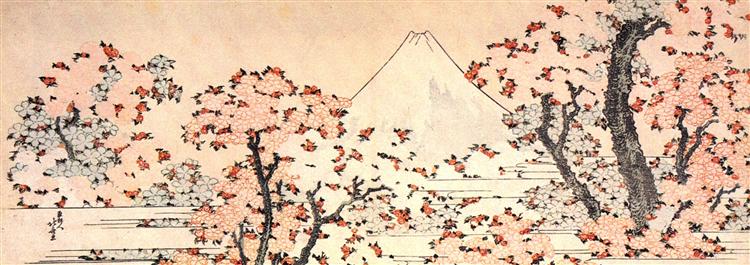Beskrivelse
The painting “Mount Fuji Seen Through Cherry Blossoms” by Katsushika Hokusai is an iconic work that encapsulates the fusion of landscape and nature in Japanese art of the Edo period. Created at a time when woodblock prints and color prints were reaching their zenith in Japan, this work comes across as a delightful amalgamation of delicacy and majesty. Hokusai, known not only for his technical prowess but also for his ability to evoke emotions through nature, strikes a perfect balance between the national icon that is Mount Fuji and the ephemeral beauty of cherry blossoms in this painting.
Looking at the painting, one perceives a balanced composition where Mount Fuji, with its gentle curves and unmistakable snow-capped peak, stands majestically in the background. The summit of the mountain takes up most of the horizontal space at the top of the picture, while cherry blossoms, with their spreading branches in a delicate pale pink and white, frame the view. This arrangement creates an atmosphere of intimacy, as if the viewer is not only observing, but experiencing a specific moment under the Japanese sky.
Hokusai uses a colour palette that highlights the sweetness of spring. The pastel tones of the flowers contrast sublimely with the deep blue of the sky, creating a delicate play of light and shadow. The use of the woodblock printing technique, which allowed Hokusai an unparalleled range of colour, is manifest here in the subtlety of the tonal transitions, particularly in the flowers and leaves, which seem to vibrate in the spring breeze. Each petal is rendered in such detail that one can almost sense the freshness of the flower itself in the air.
There are no visible characters in this work, highlighting Hokusai's intention to focus attention on natural elements and their inherent beauty. In Japanese tradition, the connection between man and nature is a recurring theme, and although there are no human figures interacting with the landscape in this work, the context suggests an invitation to contemplation and a spiritual connection with the environment. The depiction of an almost dreamlike landscape suggests the idea of a refuge of peace and beauty that, although ephemeral, is also enduring in its essence through art.
This painting can be associated with other works by Hokusai that explore similar motifs, such as The Great Wave off Kanagawa, where Mount Fuji also plays a central role in the visual narrative, albeit in a different context. Here, however, the tranquility of the spring atmosphere gives the work an introspective quality that is deep and personal. The simplicity of the landscape contrasts with the grandeur of the mountain and the fragility of the flowers, a reflection of the duality of life itself.
The work also has an important cultural background, as cherry blossoms are a national symbol in Japan, representing the transitory beauty of life and the arrival of spring. Hokusai, in capturing this ephemeral beauty, is not only photographing a moment in time, but also echoing the Buddhist philosophy that permeates much of Japanese art, in which beauty and sadness coexist in a perpetual dance.
“Mount Fuji Seen Through Cherry Blossoms” is ultimately a testament to Hokusai’s virtuosity and his ability to fuse color, form and meaning in a work that continues to resonate with contemporary audiences. In this painting, the viewer is transported into a space where nature is not just a background, but the true protagonist of a story that invites contemplation and appreciation of life in its purest form.
KUADROS ©, a famous painting on your wall.
Hand-made oil painting reproductions, with the quality of professional artists and the distinctive seal of KUADROS ©.
Painting reproduction service with satisfaction guarantee. If you are not completely satisfied with the replica of your painting, we will refund 100% of your money.

